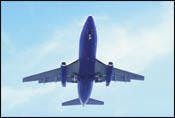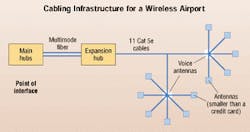Infrastructure design gives new life to Category 5e cable.
Providing wireless access to air travelers is creating a new market for airports and service providers alike, and is an untapped opportunity for communications designers and installers. The Telecommunications Act of 1996 states that publicly owned facilities must provide equal access to any cellular or data carrier wishing to provide service within its buildings, and nowhere is that more evident today than the nation's airports.
But the process of bringing these signals inside continues to be extremely difficult, especially for anyone who designs, manufactures, and installs cabling infrastructure. As airports work to comply with new legislation, many are looking to invest in a communications system that will let them provide necessary infrastructure to carriers, rather than simply allowing free access to all service providers.
Airports want control over the infrastructure being installed in their facilities, and are consequently turning to cabling designers and installers for systems that will comply with the law in addition to benefiting overall airport operations. Even wireless systems must ultimately transmit their signals on terrestrial networks, and airports present uniquely challenging environments in which to operate data and telecommunications networks. They are damp, dusty environments, plagued with heavy vibrations from planes and electromagnetic interference (EMI) from flight and ground communications equipment.
Traditional cellular and wireless towers stationed outside of airports have a difficult time meeting the demands of mobile device users because of distance limitations and EMI. In addition, airport buildings are made of heavy steel and concrete materials that essentially block out signals and prevent them from reaching indoor users. The result is limited or no service, and unreliable connections for travelers using devices such as cell phones, wireless modems, PDAs, or Blackberry. If the EMI alone doesn't disrupt signal transmission, then the vibrations from planes taking off and landing will-connections are literally shaken loose in a matter of months.
Despite these adverse conditions, ITT Industries, Network Systems & Services (www.ittnss.com) and Aurora Electric (www.auroraelec.com), engaged in a project to wire every passenger terminal in the New York metropolitan area's three main airports for wireless access. Newark (NJ) International Airport served as the installation prototype, and John F. Kennedy International and LaGuardia are scheduled for completion shortly.
Overcoming technical challenges
NS&S found that the best way to combat the myriad transmission problems was to provide cellular and wireless data signals inside of the airport by wiring the facility with Category 5e shielded cabling. This cable was selected for a number of important technical reasons, ranging from thickness to structural design.
The copper used in the ITT cable is slightly thicker than normal (.053 mm as opposed to .050 mm), resulting in a stronger signal. And the stronger the signal, the more resilient it is to noise interference. In addition, the copper pairs are twisted to different, unique twist ratios to provide optimum protection from internal crosstalk (electromagnetic signal coupling between internal copper pairs).
While the cable's design is the major factor in balancing the internal electrical characteristics of data transmission, it does not protect against external noise such as alien crosstalk and EMI/RFI. Alien crosstalk is electromagnetic signal coupling between the pairs of two cables lying next to each other. If the same twist ratios of these different cables happen to lie next to each other, then perfect coupling can occur.
The only real protection is shielded cable. The shield prevents signals from exiting the cable, which eliminates alien crosstalk, and it prevents external noise from entering the cable. The shield is grounded to building steel, so antenna noise hitting the cable is grabbed by the shield and sent to ground. EMI/RFI is external noise entering the cable from sources such as generators, transformers, or-as in this case-airport flight and ground communications equipment. Grounding, therefore, prevents the EMI/RFI from disturbing the electrical signal inside the cable.
Several different types of shielded cabling can be used in data networks, the two most common being braided and solid. Braided shielding is most often used in Germany, while solid-foil shielding has become a standard for the rest of the world. When considering the type of shield to use in a highly industrial environment, solid shielding represents a better form of protection from external noise. In a low to moderate noise environment, braided shielding can also be effective, although some noise passes though the holes in the braid.
In addition to keeping external noise from affecting data transmission performance, shielded cable contains data within the cable. While traditional unshielded cable does not release enough noise to significantly impact exterior systems, data containment can be an issue of security-especially important in the context of air travel. Ensuring that data systems not only perform well, but also have no adverse effects on systems running within a close proximity, is an essential feature of the cable used for an airport installation. There can be no interference with other vital communications systems.
While Category 6 shielded cable provides better results with internal noise (near-end crosstalk-NEXT, and far-end crosstalk-FEXT), its performance with respect to external noise is equal to the less expensive Cat 5e shielded cable. Although Cat 6 cable provides better signal levels for high-speed data applications, the very tight twist ratios used to achieve these levels create time delays between cable pairs. Therefore, for most data applications, including gigabit, Cat 5e is the better choice.
Retrofit issues
After overcoming the challenges of selecting the best possible cabling, the installation of the physical system posed many new obstacles. "Any time you have to retrofit a structure with a complex data system, especially a public structure, it creates a unique set of installation challenges," says Veronica Rose, president and CEO of Aurora Electric-the data communications and electrical installation company that installed the system. "There was no one method that worked everywhere."
Each section of the airport installation features a different set of environmental parameters requiring unique solutions. For example, Aurora Electric discovered that the screw attachments holding the antennas to some of the ceiling surfaces periodically came loose due to building vibrations. As a remedy, Aurora found a new epoxy that provides significantly greater performance under adverse conditions.
Numerous other installation techniques have been established for mounting the antennas. This is not a "normal" installation because contact between any form of metal and an antenna results in interference. Traditional attachment devices such as screws and anchors have since been replaced with plastic connectors and epoxy.
Aurora Electric also considered practical elements, such as how future renovations and demolitions would impact the network, and when installation could be carried out to minimize the impact on travelers. Careful network design and planning, plus labeling mechanisms with ample contact information, alleviated the first concern. To address the second challenge, the Aurora team worked unconventional hours-typically, from 10 p.m. to 6 a.m. Otherwise, work sessions are interrupted due to flight cancellations or delays keeping passengers in the airport longer.
"Obviously, when working in a very busy community structure, public safety as well as convenience are of utmost concern," Rose said. "Airports operate like entire cities in one-fourth of the space, so it is important to understand what hazards and disruptions installations like this present."
The completed system
When all components are designed and methods are in place, it takes an estimated three months to wire an airport terminal-down from the 10 months it took for the prototype installation at Newark. The finished system includes infrastructure to support five voice carriers and six data carriers at Newark, and will support seven voice carriers and six data carriers at each of the other two New York airports. In all, the system is constructed from 57 miles of ITT shielded cable, with 250 antennas at Newark alone.
Current and projected market trends in the wireless industry create strong arguments for installations like the ones in the New York area airports. It is estimated that 40% of travelers will be using these systems at Newark, Kennedy and LaGuardia, generating collective revenue for the airports of $180 million over the next 10 years. And this number is expected to increase as the number of cellular and wireless data users increases. In fact, Jupiter Media Metrix (www.jmm.com) estimates that there will be 83 million wireless Internet users in the U.S. by 2005 (1.17 billion worldwide).
Equipping airports with infrastructure capable of supporting wireless access is a service that is providing a ripe market opportunity for cabling designers, manufacturers and installers. Current market demand is strong, and will continue to grow along with the demand for wireless Internet access.
And the good news for the cabling industry is that the growth of wireless communication is not feasible without the growth and innovation of terrestrial networks.
Jonathan Chauvin-Blitt is president of ITT Industries, Network Systems & Services, New York City (www.ittnss.com).


